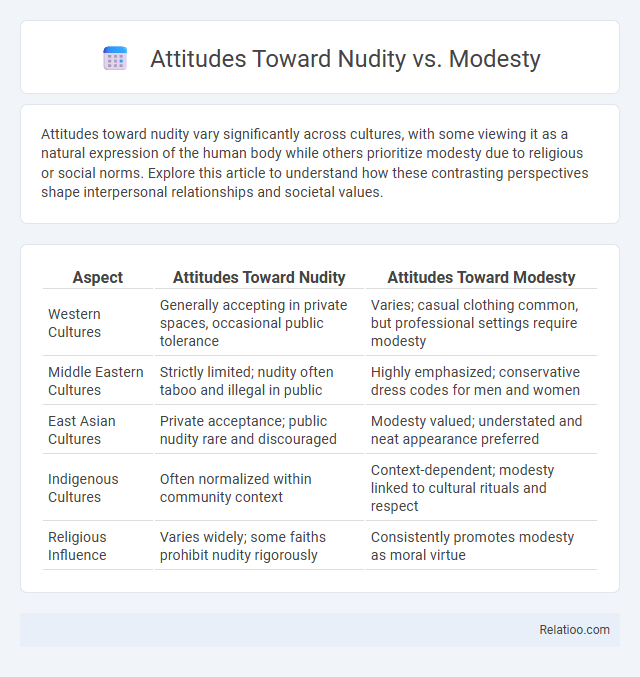Attitudes toward nudity vary significantly across cultures, with some viewing it as a natural expression of the human body while others prioritize modesty due to religious or social norms. Explore this article to understand how these contrasting perspectives shape interpersonal relationships and societal values.
Table of Comparison
| Aspect | Attitudes Toward Nudity | Attitudes Toward Modesty |
|---|---|---|
| Western Cultures | Generally accepting in private spaces, occasional public tolerance | Varies; casual clothing common, but professional settings require modesty |
| Middle Eastern Cultures | Strictly limited; nudity often taboo and illegal in public | Highly emphasized; conservative dress codes for men and women |
| East Asian Cultures | Private acceptance; public nudity rare and discouraged | Modesty valued; understated and neat appearance preferred |
| Indigenous Cultures | Often normalized within community context | Context-dependent; modesty linked to cultural rituals and respect |
| Religious Influence | Varies widely; some faiths prohibit nudity rigorously | Consistently promotes modesty as moral virtue |
Introduction: Defining Nudity and Modesty
Nudity refers to the state of being without clothing, often examined in cultural, social, and psychological contexts to understand its varying significance across societies. Modesty involves behaviors and attitudes aimed at minimizing exposure of the body, reflecting deeply ingrained cultural norms and personal values. The distinction between nudity and modesty shapes societal taboos by influencing what is considered acceptable or forbidden public behavior.
Historical Perspectives on Body Exposure
Throughout history, attitudes toward nudity, modesty, and taboo have varied significantly across cultures, reflecting social, religious, and political influences. In ancient Greece, public nudity symbolized heroism and athleticism, whereas medieval Europe emphasized modesty shaped by Christian doctrine, rendering nudity a moral transgression. Indigenous societies often embraced body exposure as a natural state linked to spiritual and communal identity, contrasting sharply with modern Western taboos that associate nudity with sexuality and impropriety.
Cultural Attitudes Toward Nudity
Cultural attitudes toward nudity vary widely, influenced by historical, religious, and social norms that shape perceptions of modesty and taboo. In some societies, nudity is embraced as a natural state and symbol of freedom, while others enforce strict dress codes reflecting values of decency and respect. Understanding these diverse perspectives can help you navigate social settings with cultural sensitivity and awareness.
Social Norms Shaping Modesty
Social norms play a critical role in shaping attitudes toward modesty by defining acceptable levels of body exposure within different cultures and communities. These norms influence individual behavior, guiding what is considered appropriate or taboo, and impacting your comfort with nudity in public or private settings. Understanding how social expectations evolve helps explain the diverse perspectives on modesty worldwide.
Psychological Impacts of Nudity and Modesty
Nudity can promote psychological benefits such as increased body acceptance, reduced anxiety, and enhanced self-esteem by fostering a natural, non-judgmental connection with one's body. In contrast, strict adherence to modesty often reflects cultural or societal norms that can induce feelings of shame or guilt, potentially limiting emotional expression and personal freedom. The perception of nudity as taboo may exacerbate stress and negative self-image, reinforcing harmful stereotypes and hindering mental health development.
Religion and Moral Views on Body Display
Religious doctrines often shape attitudes toward nudity, intertwining modesty with moral values that emphasize covering the body to maintain spiritual purity and social order. Many faiths regard public nudity as taboo, associating it with temptation, sin, or disrespect, thus enforcing strict dress codes as expressions of devotion and ethical conduct. These moral views influence cultural norms, where modesty is equated with virtue and adherence to divine commandments governing body display.
Media Influence on Perceptions of Nudity
Media plays a significant role in shaping public attitudes toward nudity by often polarizing its portrayal between artistic expression and sensationalism, affecting societal norms on modesty and taboo. Television, films, and social media platforms frequently negotiate nudity within cultural contexts, either normalizing it through progressive representations or reinforcing taboos by framing it as scandalous or inappropriate. These media narratives influence individual perceptions by repeatedly associating nudity with either freedom and authenticity or shame and disruption, thereby impacting social acceptance and personal comfort levels.
Legal Regulations and Public Decency Laws
Legal regulations surrounding nudity vary significantly across regions, with public decency laws aiming to balance personal freedoms and societal norms. Your understanding of these laws is crucial, as offenses can result in fines or imprisonment depending on the jurisdiction's strictness toward public nudity. Modesty standards often influence legislation, shaping how authorities interpret and enforce nudity and taboo in public spaces.
Nudity and Modesty in Art and Fashion
Nudity in art and fashion often symbolizes freedom, vulnerability, and natural beauty, challenging societal norms and encouraging viewers to confront their perceptions of the human body. Modesty, on the other hand, is typically expressed through clothing and design choices that emphasize discretion and cultural values, shaping how self-expression is balanced with social expectations. Your appreciation of these contrasting attitudes can influence how you engage with creative works that either celebrate or restrict the display of the human form.
Future Trends in Attitudes Toward Nudity vs Modesty
Future trends in attitudes toward nudity versus modesty indicate a shift toward greater acceptance and normalization of body positivity and natural expression, influenced by evolving cultural perspectives and social media platforms promoting inclusivity. Research shows younger generations increasingly view nudity as a form of personal freedom rather than taboo, challenging traditional modesty norms rooted in religion and societal expectations. Your understanding of these trends can help navigate and adapt to the changing landscapes of social behavior and fashion, reflecting a more open-minded approach to individuality and self-expression.

Infographic: Attitudes Toward Nudity vs Modesty
 relatioo.com
relatioo.com